Gravity: Double Review
Below are a pair of reviews concerning the film, Gravity. Both reviews contain copious amounts of SPOILERS. DO NOT READ if you do not want to know about plot details.
STEVEN:
Alfonso Cuaron’s Gravity might be the most visually stunning film I have ever seen. Much of the film involves actors walking around in space outside of shuttles or satellites, so the technical achievement of this movie is ongoing—every frame defies the expectations of what a movie in our day and age should be able to depict. This continuous barrage of awe-inspiring direction, cinematography and special effects is further marked by shots of even greater magnificence, including a meteor shower-like scene near the end that blends masterfully with a chill-inducing score. Barring miraculous developments from now until February, anything short of a win for Alfonso Cuaron in the Oscars’ “Best Director” category should be a violation of international law. Watch Gravity in 3-D before it exits theatres—you owe it to yourself.
My recommendation that everyone see this movie is a testament to Gravity’s visual and technical achievements because quite frankly, the rest of the movie was mostly mediocre. Mr. Cuaron, while a directorial genius, is an average writer and the script for the film reads like an anthology of thriller film clichés. A bad script transfers into a bad plot and characters that we don’t care too much about—thank goodness Cuaron gave us spellbindingly awesome things to look at while we dozed off about the storyline.
Gravity is centered on a medical engineer, Dr. Ryan Stone, who is played by Sandra Bullock. George Clooney is the only other actor whose face we see and he plays veteran astronaut Matt Kowalski, who is on his final mission. The film begins with a routine repair job on the Hubble Space Telescope as the two astronauts communicate with Mission Control, voiced by Ed Harris (an intentional nod to Apollo 13, in which Harris played Mission Control commander Gene Kranz). The mission is tragically cut short, however, by the explosion of a satellite, which sends debris on a high-velocity orbit in the Hubble’s direction. Stone and Kowalski are the only survivors when the debris storm strikes and the two “hike” to the ISS, hoping to hop aboard a Soyuz craft and return home. Unfortunately, Kowalski’s thrusters run out of fuel and without navigational capabilities, the two astronauts hit the ISS hard and are entangled in rope and wiring—prepare for the first major cliché. Stone is attached to the ISS by a rope that hooked around her foot but Kowalski oh-so-heroically detaches himself from her so that she could “save herself” and not be dragged into the abyss. I must admit I began chuckling out loud in the theatre during this scene. I could almost hear screams of despair from women all across America as George Clooney drifted off into oblivion. Of course, we all know this to be the death of his character. Yet, seeing Kowalski tumble away but remain in view for quite some time was more awkward than sad. It doesn’t help that we only knew Kowalski for about half an hour before his untimely passing.
Without Kowalski, Stone is now alone for the rest of film. She makes her way into the ISS but then must escape due to a fire. She escapes the ISS but, alas, she has no fuel! Cuaron sends us one “obstacle” after another even though we know the final resolution—Ryan Stone will survive. Now, to be fair, knowing that the protagonist will survive does not break a disaster film like this one. In fact, another space drama, Apollo 13 had an ending that everyone saw coming (considering that it depicted a historical event). However, I must say that I frankly didn’t care very much about Stone’s fate. I cared on a general level in that I don’t want people to die. However, the film gave little reason to become invested in Bullock’s character. We are given little insight into her as a person—we know that her daughter died in a freak accident and that this haunts her, but so little time is given to this concept that we are forced to fill in between the lines. Apollo 13 was a great narrative film because we were able to see the characters before they were in space, seeing their complete lives as human beings. Moreover, during the disaster of the Apollo mission itself, the movie frequently returned to Mission Control and the families of the astronauts—we were rooting for the return of Jim Lovell, Fred Haise and Jack Swigert along with the rest of the United States and beyond. Stone’s communication with Mission Control was severed, so characterization in this movie obviously couldn’t have taken the same direction as in Apollo 13, yet I’m certain that there are storytelling alternatives which could have done greater justice to the superb visuals of Gravity. The movie naturally concludes with Stone’s return to Earth and this is made possible by a dream sequence in which Kowalski “returns” and gives Stone a pep talk and some pointers. At that point, my cliché detector shrieked and exploded into a million pieces. Dr. Ryan Stone, reinvigorated after losing hope, is able to get to Chinese satellite “Tiangong” and ride a landing module back onto Earth—but not before she encounters some last minute obstacles like an instrument fire and a near-drowning. Can’t this girl get a break? The victorious astronaut-engineer-hero steps onto a sandy bank and takes some uneven steps, stumbling onto the ground but smiling nonetheless. The screen goes black and the title plays—Gravity. (Get it? She stumbles onto the ground because there is gravity on Earth and she’s thankful for it and then the screen shows “Gravity”. How witty!) The chosen title for this movie is somewhat ironic—it has been marketed as a story of unpredictability, an adventure of uncertainty. Yet, it is named after the one thing we can all be sure of—gravity.
Now that I’m done pointing out the staggering shortcomings of the film’s narrative aspects in relative to its breathtaking presentation, I must take a step back. Gravity is one of the year’s best films. Sure, it was basically a master-class in style over substance, but the achievements of this film are absolutely undeniable and Bullock’s performance is remarkable considering the dialogue that she had to work with. The evolution of Stone also offers some narrative salvation, although her movement away from someone who could never “let go” was through epiphany—a little bit lazy. There is also religious thematic material, although such themes are, as Mr. Ebert once said, answers and not solutions. At the end of it all, the story may be forgettable but you’re in for a hell of a ride—so hellishly thrilling that you may not notice the story’s clichés or shortcomings. That, ladies and gentlemen, is impressive. Gravity is a landmark of modern filmmaking.
KEVIN:
Words are pale and powerless to describe this film. I can tell you this, that Gravity is a once-in-a-generation film. A landmark. A milestone. But it’s impossible for me to tell you why. Not with words.
“Gravity” is a pure, ethereal cinematic experience, a film-film. For most movies nowadays there is virtually no difference between watching it on a 15-inch computer screen with stereo sound and experiencing it on a 57-feet screen with surround sound. For some movies, there is not even a difference between watching it and reading it on paper.
“Gravity” demands to (and must) be experienced in theatre in 3D to be immersed in its full glory. How can I possibly explain to you the magnificence of this experience, without ruining every bit of it?
I’ll try what most professional and prolific critics do to fill their reviews: describe the plot and assign adjectives to aspects of it. It’s a space survival story. Its visuals is breathtaking, astonishing, and enthralling. Its music intense, magnificent. Its acting powerful and moving. Its story simple, elegant, glorious, profound, and deeply heart-felt. Does this help? No. But what more can I say? I do not wish to take away from your experience. The best I can say is simply “Go watch it.”
Now I’ll try to explain, but I will have to spoil every bit of it.
Gravity’s reputation precedes itself. You will have heard this, and it is certainly true: Gravity is, first and foremost, a visual marvel. Like its most esteemed predecessors – Avatar, Hugo, and Life of Pi, Gravity shines with the rarest brilliance: its visual effects and 3D serve not as gimmicks but as a vital part of its artistic values. It achieved what so many films strive for but cannot reach: transporting us into a different time and space, transforming its fictional dreamscape into harrowing reality.
The truth is that Hollywood has in recent years become so proficient at special effects that most of its popcorn blockbusters’ visuals are no longer spectacles but standards. Audience are now too sophisticated to be awed by visual effects.
That’s where Gravity stands out. After so many have tried and failed for so long, it miraculously reawoken our desire for marvels. It, somehow, stunned the audience of 2013 as easily and as powerfully as the first motion picture did to the audience of 1895. They, then, having never before witnessed a film, were scared soulless by a silent train’s arrival on black-and-white motion picture; we, now, seasoned from the thousands of movies we’ve watched, are somehow again jaw-dropped, awe-inspired, and enthralled by a woman’s escape from space.
Gravity has gone even further, accomplishing the near-impossible feat of cheating our physical senses – through nothing but a compilation of sight and sound. Ever since the first shot of the film – which opens as a breathtaking extreme wide shot of Earth and the Hubble and soon extends into an astonishing 16-minute long take – Alfonso Cuarón and cinematographer Emmanuel Lubezki have choreographed their camera so delicately that the film’s visual will constantly reorient or disorient our vision, matching exactly either our protagonist’s orientation or disorientation. The cinematography was so insanely effective that, in fact, I would, from time to time, feel weightless, floating. Later in the fire sequence in Tiangong, this effect was manifested only more powerfully: for a brief moment as the fire rushes toward me, licking, hissing, roaring, I felt the heat and smelt the fire.
Either my sense or my senses has abandoned me. Since I’d prefer not to think of myself as crazy, I’ll say it’s the senses. I found it… simply incredible. Just through a certain combination of image and sound effects, a film has cheated my body into feeling what my e mind knows does not exist. When a film is able to completely not only suspend, but destroy your disbelief – what an amazing feat! I know this has been said numerous times and ascribed to only too many movies, but I still have to say it, for Gravity is truly the only movie that has achieved it: it feels as if, with Cuarón’s many magnificent long takes, we were right there and then, in the place of the camera, floating around our characters, spectating, following, participating, being.
How Cuarón managed to achieve this, I can’t really explain. The devil is in the details. Every shot, every take, every cut, every sound, every note of the music, and every gesture of the acting are set out in such a way that the film comes together so perfectly into one powerful, enthralling, and glorious piece.
Oh, the acting. If Sandra Bullock’s performance been any less, this would have a been a much lesser film. Many are predicting Bullock as the strongest Oscar contender so far – alongside Cate Blanchett for her performance in Blue Jasmine. And Bullock deserves every bit of the praise she has received. For the most part of Gravity, there is only one character, our protagonist Dr. Ryan Stone played by Bullock. The strong link of empathy between the character and the audience that Cuarón has so meticulously constructed with visuals and music would have fallen apart without Bullock’s performance. Her every gesture, every facial expression, every word, even the way she breathes – especially the way she breathes – play perfectly into the film.
Even Gravity’s harshest critics could not deny its technical achievements and Bullock’s performance. Most, however, never really saw enough into its story. Sure, Gravity’s visual accomplishments is what rendered the film a landmark, but without such an elegant and profound story Gravity could but be another Avatar. But it really is closer to Life of Pi.
Many have compared Gravity to 2001: a Space Odyssey, and for good reasons: both are groundbreaking technical marvels set in space, and both explore the theme of “our inner evolution”, as Cuarón calls it. But they are on two extreme ends of the same spectrum. Kubrick’s 2001 took a perspective few directors dared or could – some call it God’s view. 2001 looked at our species on such an immense scale that on the surface it seems all human emotions have been deprived of in the film. Gravity is much more personal, intimate, and emotional. It’s much simpler.
But it’s a beautiful, elegant simplicity.
Theme-wise, Gravity is more or less a sibling of Cuarón’s previous work, his 2006 masterpiece Children of Men. Like Children of Men, Gravity managed to tell so much with so little – except this time Cuarón presents even less, yet delivered just as much. On the surface both Gravity and Children of Men take the disguise of ordinary thrillers. Gravity’s outline looks plain and cliché – space survival, last-minute rescues, a heart-breaking sacrifice, danger after danger, coincidence after coincidence, impossibilities one after another, and, in the end, protagonist survives. We’ve seen it all before.
But it’s not what the film tells, but how the film tells it. Gravity does everything just right so that we can hardly feel the presence of these story clichés. Every danger is scientifically possible. And as a result, none of the dangers felts forced, unnatural, or distracting. As for the unlikelihood of so many disasters in so short a time and so rapid a succession – which only too many people have questioned, the film presented a seamless and revelatory explanation – in the dialogues between Dr. Stone and Kowalski (George Clooney), she mentioned the seemingly ridiculous cause of her daughter’s death: she was playing tag; she hit her head, and just died. Seemingly impossible, yes. But have we not seen things like this? Have we not witnessed the impossible constantly taking place, ever since our very births? Unlikely but natural survivals of some; unlikely but natural deaths of others. Sometimes the miraculous is common, and the very likely never takes place.
Undeniably, Kowalski’s sacrifice feels distracting and cliché – but only initially. Immediately we come to the realization that it plays perfectly into the film’s overarching theme of letting-go – ironically, Gravity’s famous tagline is “Don’t Let Go”.
This is also the underlying theme of the beautiful subplot about Stone’s daughter – the gravity that bound her, restricted her, kept her on the ground; the gravity that never let her go.
Gravity is so much more than just a thriller in space. So many scenes are bound to become timeless classics in the near future. The constant imagery of tether – the tether between Stone and Kowalski that she was so afraid of letting go, the tether between a child and a mother. The scene of rebirth after Stone reached the ISS, as she slowly curves into a fetal position and floats quietly in zero-gravity. The incredible conversation between Stone and Aningaaq, which spans through 300 miles, two races, two languages, and two worlds.
And the final sequence. The sequence of rebirth and evolution. She starts in the ocean – fish, climbs ashore with all four limbs – amphibians, struggles and manages to stand, upright and erec. Then she slowly toddles inland – the birth of Man.
Like Children of Men this is Cuarón’s love song to humanity. How weak we are, upset, beaten, and destroyed by chance. How strong we are, victorious against all odds, all the malevolence of probability! We are so easily triumphed over by the smallest thing; we can so easily rise up again for the smallest thing. Unlike animals we possess more than just instincts. We struggle not just for survival; we strive to enjoy the ride no matter what. Kubrick’s Starchild is not in the far future; it’s already here. We are it.
STEVEN: 8.5/10
KEVIN: 10/10



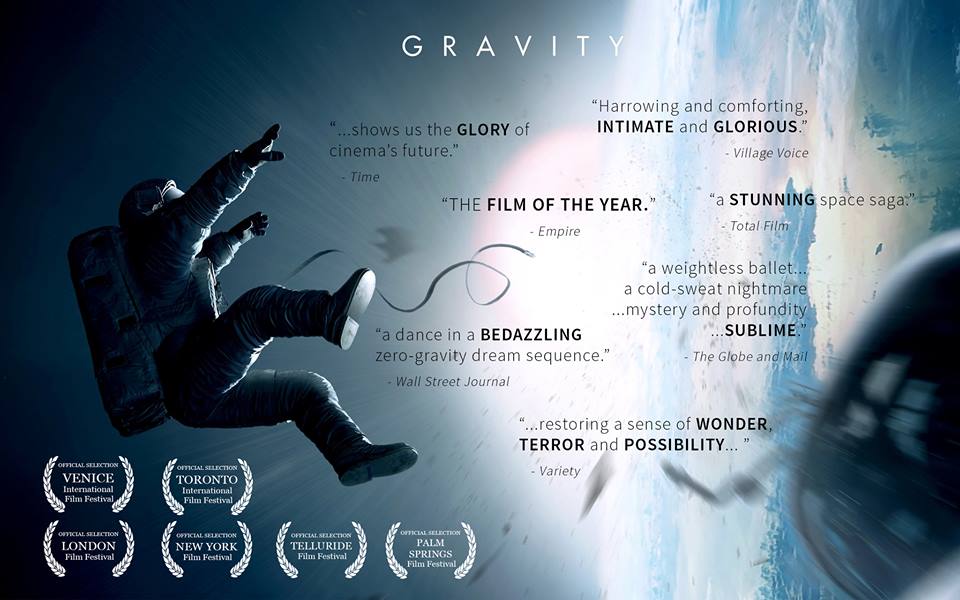
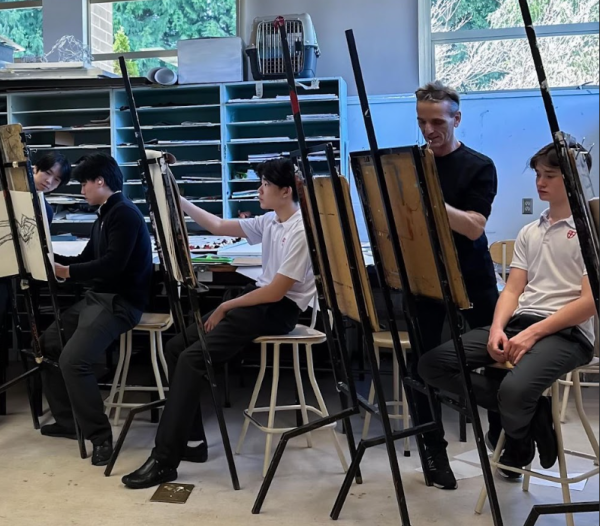


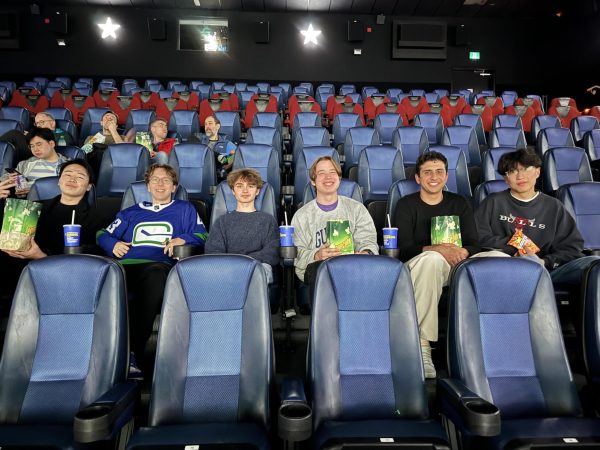
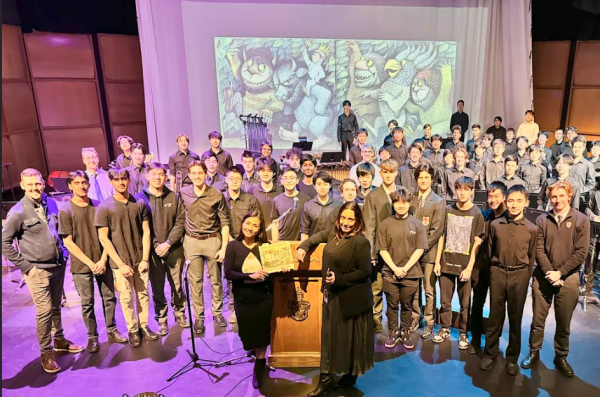





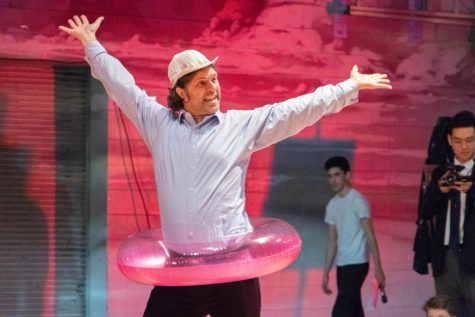

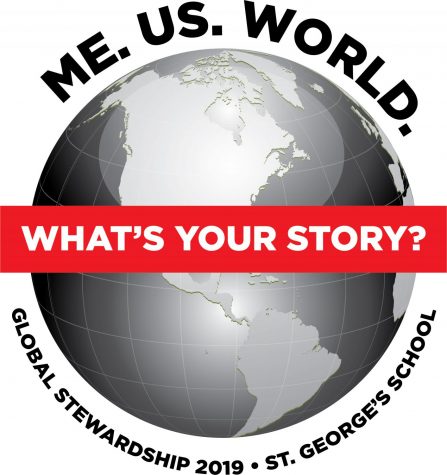

Jason • Nov 23, 2013 at 11:49 am
As much as I hate to do so, I have to agree with Kevin. After all, GRAVITY’s story is has far, far more metaphor as Steven has put it out to be. It seems as though Steven actually glosses over the central, reoccurring themes of loneliness, of feeling out of control, of having to let go; all of which are instantly relatable to the audience. I feel, that to truly be engaged by GRAVITY, one needs to look below the surface, and to be unfazed by the seeming trivial plot and simply dazzled by the effects. Finally, GRAVITY’s setting in space isn’t meant to distance us physically from the story, it’s meant to capture us, engage us, and allow us to interpret it all the way we wish.